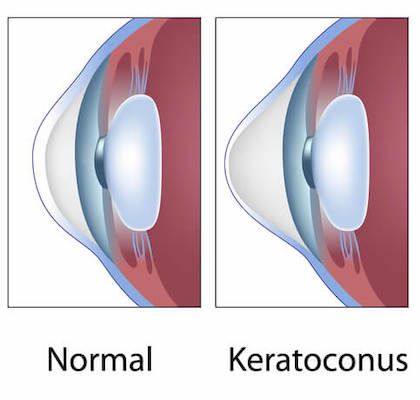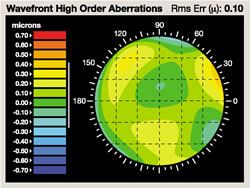Keratoconus
“Keratoconus literally means cone-shaped cornea.”-AAO
Are you suffering from vision problems related to keratoconus? Are you seeking expert ophthalmic eye care for this problem? If so the keratoconus specialists at Coastal Vision Medical Group Medical can possibly help. Feel free to read some of our information regarding keratoconus and keratoconus treatment options below.

What is the Cornea and How Does this Relate to Keratoconus?
The cornea is the window and outer surface of the eye. When you are interpreting an image light travels through the cornea past the lens to the retina and then the brain to form a visual image. The normal corneal surface is smooth and aspheric and flattens towards the edges. Light rays passing through it moves in an undistorted manner to the retina to project a clear image to the brain. This is the typical normal working cornea.
Keratoconus is a very slow progressive eye condition that affects the cornea. The normally round, dome-shaped cornea weakens and thins, causing a cone-like bulge to develop. The regular curvature of the cornea becomes irregular, resulting in increasing nearsightedness (myopia) and astigmatism that have to be corrected with special glasses or contact lenses. Since the cornea is responsible for refracting most of the light coming into the eye, corneal abnormalities can result in significant visual impairment, making simple tasks like driving or reading books is more challenging.
Symptoms of Keratoconus (EYE FACTS AAO worksheet, 2010)
mild burning
glare at night
irritable eye
sensitivity to light
some distortion of vision

Dealing with Keratoconus
When you are a keratoconus patient your cornea is irregular and cone-shaped. Eyeglasses will not adequately correct vision since they cannot conform to the shape of the eye. The general approach to vision correction is to use rigid contact lenses since these lenses provide a clear surface in front of the cornea allowing the light rays to be projected clearly to the retina. Scleral contact lenses may also be an option prior to considering surgery.
When Keratoconus Worsens
Over time, keratoconus can progress with more severity. Vision will no longer be correctable with glasses. Iron will deposit around the base of the protrusion and the tissue will thin. In severe cases, a temporary painful condition called acute hydrops may occur when water rushes into the thinned area of the cornea. Penetrating keratoplasty or corneal transplant surgery should be considered at this point.
Dr. Dan Tran was the first surgeon in the world to combine the commercial use of IntraLase technology with intracorneal rings (Intacs) to treat patients with keratoconus; a disorder that leads to a loss of vision in young adults. With his expertise, Dr. Tran has been instrumental in mentoring other surgeons around the world about this treatment. If you are seeking an Orange County cornea specialist to treat keratoconus do not hesitate to contact us about the use of Intacs in treating keratoconus.







